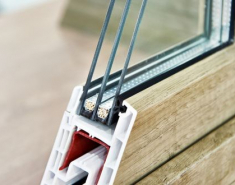How to Choose the Right Replacement Windows
Synopsis: If you have an outdated home with wood windows, replacement windows can be a good alternative to new-construction windows – they cost less to install, and they leave trim and molding in place. On the flip side, installing replacement windows means there is no chance to access the details around the window and improve air-sealing and insulation; and with replacements, proper installation can make or break the unit’s performance. Contributing editor Asa Christiana describes when replacement windows make sense, and when they don’t; the steps to a proper installation; and additional alternatives for improving the performance of outdated windows.
Selected and used properly, replacement windows can be a godsend for older homes with outdated wood windows—installing quickly into existing window frames at less cost than new-construction windows, preserving interior and exterior details, and vastly improving the performance of one of the key parts of the building envelope.
Bought from a hard-sell outfit, however, and installed by lower-skilled technicians, replacement windows can be a big mistake, costing a bundle for a result that looks only so-so, operates poorly, and performs even worse.
To find out when replacement windows make the most sense and learn the critical steps of a proper installation, it’s important first to understand how these units work.
Replacement basics
Most of today’s replacement windows, also called “pocket replacements” or “insert replacements,” include a full frame with sashes inside, very similar to a new- construction window but without the nail fin at the edge. Developed primarily for improving old wood windows, these full-frame replacements are manufactured to order, custom-sized to fit into the existing frame with only a narrow gap around the edges.
Because they add a frame inside the existing frame, replacement windows have smaller sashes than the originals, resulting in less glass and diminished daylighting accordingly. Although replacement windows are most often pushed tight to the exterior trim, these windows have narrower frames than new-construction windows, so they can be placed at different positions— favoring the exterior side, favoring the interior side, or right in the middle of the jambs—depending on existing trim and other conditions.
More about windows:
Get the Right Windows – Three basic steps to make sure you’re up to date with the changing window market.
Should I Replace My Old Windows? – Energy Nerd: The cost to make and transport new windows vs better efficiency.
Learning to Install Windows – Students do the tricky (and sticky) work of installing windows in the FHB House’s hi-performance wall assembly.
Source: https://bit.ly/3d934V8









